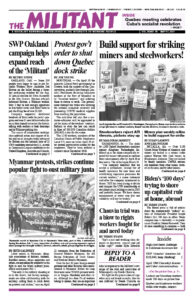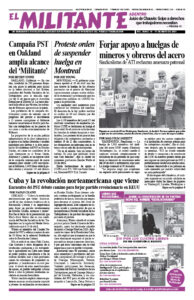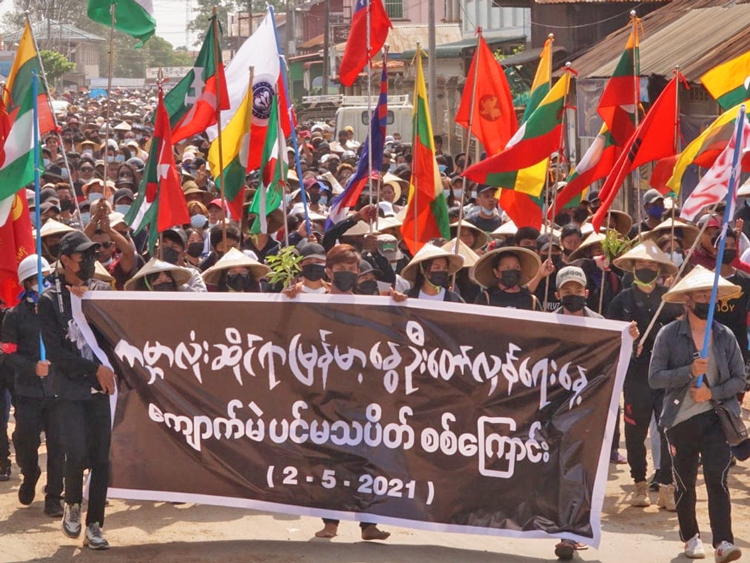Labor unions in Myanmar, alongside associations of farmers, students, Buddhist monks, ethnic minorities and others, are appealing for solidarity in the fight to oust the brutal military junta, which seized power Feb. 1.
“Not only is the military shooting at us in the streets, but factory managements are often collaborating with the military, calling them to crack down on protests and strikes,” says an April 22 statement from the Federation of General Workers Myanmar, the All Burma Federation of Trade Unions and Food not Bombs Myanmar.
Over the last 10 years foreign-owned garment and other factories have mushroomed in Myanmar. Before the coup there were some 700,000 garment workers in Yangon, Mandalay and other cities. Although less than 1% of workers belong to unions, they are an important part of resistance to the coup.
The day after the generals dissolved parliament and arrested leaders of the governing National League for Democracy, the junta invited the Confederation of Trade Unions Myanmar to be part of a “social dialogue.” A coalition of unions and farmers groups rejected the “invitation,” calling a nationwide strike that shut down much of train service as well as a large section of garment shops, mining, the oil industry and public hospitals.
Union leaders driven into hiding
Khaing Zar Aung, president of the Industrial Workers’ Federation of Myanmar, said in a statement April 22 that after 37 mostly Chinese-owned factories in Yangon were set on fire by unknown arsonists March 14-15, “many trade union leaders had to go into hiding, because the military started searching for them.”
The junta used the fires as a pretext to step up repression. As of May 5, the regime has killed 769 people and jailed 3,696. Thousands of factory workers left without work returned to their home villages in the countryside.
Now “most factories have reopened,” Khaing Zar Aung said, but the bosses have fired thousands of workers who didn’t return, as well as union militants. The union is demanding unpaid leave for those who can’t come to work and severance pay to laid-off workers.
While protests have gotten smaller under the repressive blows, they continue. Thousands around the country joined “Spring Revolution” protests across the country May 2. Solidarity actions took place in the U.S., Taiwan, British Columbia and London, where exiled Hong Kong protest leader Nathan Law took part.
The junta’s propaganda daily The Global New Light of Myanmar recognized the impact of the protests in a front-page article April 23, demanding supporters of “CDM” — the Civil Disobedience Movement — “return to their workplaces as quickly as possible.”
The paper has printed the names of dozens of doctors, celebrities and students indicted for “inciting” opposition to the regime and supporting a shadow “national unity” government set up by ousted members of parliament.
Junta fears fracture in the army
Irrawaddy, an opposition news media, recently got hold of some internal army memos. One April 11 memo instructs soldiers to “annihilate” protesters. An April 14 memo admits there are protests in “every township in Sagaing, Mandalay, Yangon and Bago regions and in Mon State.”
Showing its lack of confidence in the loyalty of rank-and-file soldiers — most from farm villages as well as working-class families in the cities — the high command is prohibiting “troops and families from listening to the media.” They banned use of Facebook, and instructed officers to bar “strangers” from military camps. The junta relies mostly on police and elite army units, infamous for “counterinsurgency” against ethnic minorities, to attack protests and strikes.
From before the time the British rulers conquered Myanmar, then called Burma, it has never been one unified nation. British colonial rule with its divide-and-rule strategy further pitted the Bamar ethnic majority and more than 135 ethnic minorities against each other.
Though they succeeded in ending British colonial rule in 1948, the independence movement didn’t unite working people regardless of ethnicity or religion. Those independence fighters who considered themselves Marxists and formed communist parties were schooled by anti-revolutionary forces beholden to either Moscow or Beijing. Instead of combating the divisions fueled by imperialism, they reinforced them. Working people there still pay the price for this today.
The starkest example is that when the military launched a murderous assault on the mostly Muslim Rohingya minority in Rakine province, killing thousands and driving hundreds of thousands into exile. These attacks were backed by Aung San Suu Kyi, head of the National League for Democracy.
Many of the protesters across the country have raised the need for all working people — including all “ethnic minorities” — to come together.


